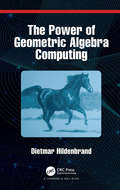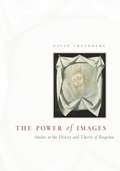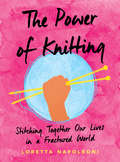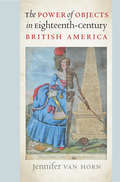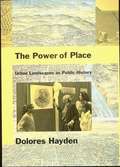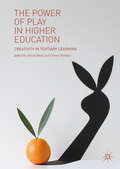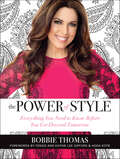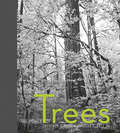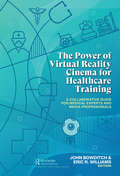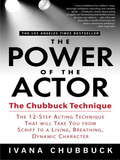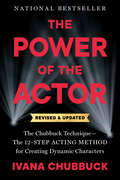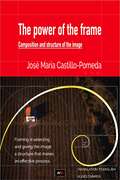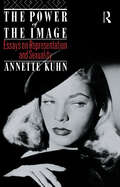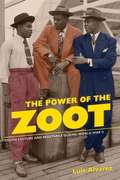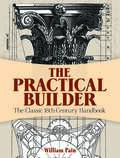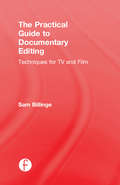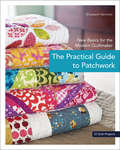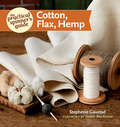- Table View
- List View
The Power of Geometric Algebra Computing: For Engineering and Quantum Computing
by Dietmar HildenbrandGeometric Algebra is a very powerful mathematical system for an easy and intuitive treatment of geometry, but the community working with it is still very small. The main goal of this book is to close this gap from a computing perspective in presenting the power of Geometric Algebra Computing for engineering applications and quantum computing. The Power of Geometric Algebra Computing is based on GAALOPWeb, a new user-friendly, web-based tool for the generation of optimized code for different programming languages as well as for the visualization of Geometric Algebra algorithms for a wide range of engineering applications. Key Features: Introduces a new web-based optimizer for Geometric Algebra algorithms Supports many programming languages as well as hardware Covers the advantages of high-dimensional algebras Includes geometrically intuitive support of quantum computing This book includes applications from the fields of computer graphics, robotics and quantum computing and will help students, engineers and researchers interested in really computing with Geometric Algebra.
The Power of Images: Studies in the History and Theory of Response
by David Freedberg"This learned and heavy volume should be placed on the shelves of every art historical library."—E. H. Gombrich, New York Review of Books "This is an engaged and passionate work by a writer with powerful convictions about art, images, aesthetics, the art establishment, and especially the discipline of art history. It is animated by an extraordinary erudition."—Arthur C. Danto, The Art Bulletin "Freedberg's ethnographic and historical range is simply stunning. . . . The Power of Images is an extraordinary critical achievement, exhilarating in its polemic against aesthetic orthodoxy, endlessly fascinating in its details. . . . This is a powerful, disturbing book."—T. J. Jackson Lears, Wilson Quarterly "Freedberg helps us to see that one cannot do justice to the images of art unless one recognizes in them the entire range of human responses, from the lowly impulses prevailing in popular imagery to their refinement in the great visions of the ages."—Rudolf Arnheim, Times Literary Supplement
The Power of Images: Studies in the History and Theory of Response
by David Freedberg"This learned and heavy volume should be placed on the shelves of every art historical library."—E. H. Gombrich, New York Review of Books "This is an engaged and passionate work by a writer with powerful convictions about art, images, aesthetics, the art establishment, and especially the discipline of art history. It is animated by an extraordinary erudition."—Arthur C. Danto, The Art Bulletin "Freedberg's ethnographic and historical range is simply stunning. . . . The Power of Images is an extraordinary critical achievement, exhilarating in its polemic against aesthetic orthodoxy, endlessly fascinating in its details. . . . This is a powerful, disturbing book."—T. J. Jackson Lears, Wilson Quarterly "Freedberg helps us to see that one cannot do justice to the images of art unless one recognizes in them the entire range of human responses, from the lowly impulses prevailing in popular imagery to their refinement in the great visions of the ages."—Rudolf Arnheim, Times Literary Supplement
The Power of Knitting: Stitching Together Our Lives in a Fractured World
by Loretta NapoleoniPurl and stitch: Empowering, healing, and reconnecting us to each other and ourselvesIn a fractured world plagued by anxiety and loneliness, knitting is coming to the rescue of people from all walks of life. Economist and lifelong knitter Loretta Napoleoni unveils the hidden power of the purl and stitch mantra: an essential tool for the survival of our species, a means for women to influence history, a soothing activity to calm us, and a powerful metaphor of life.This book is a voyage through our history following the yarn of social, economic and political changes - from ancient Egypt and Peru to modern Mongolia, from the spinning bees of the American Revolution to the knitting spies of World War II, and from the hippies' rejection of consumerism to yarnbombing protests against climate change. For the author it is also a personal journey of discovery and salvation, drawing on the wisdom her grandmother passed along as they knit together.Revealing recent discoveries in neuroscience, The Power of Knitting offers proof of the healing powers of knitting on our bodies and minds. Breaking through societal barriers, even nursing broken hearts, and helping to advance cutting-edge science, knitting is still a valuable instrument for navigating our daily lives. As a bonus, the book includes patterns for ten simple yet iconic projects that reflect the creative, empowering spirit of knitting, with complete instructions.
The Power of Objects in Eighteenth-Century British America (Published by the Omohundro Institute of Early American History and Culture and the University of North Carolina Press)
by Jennifer Van HornOver the course of the eighteenth century, Anglo-Americans purchased an unprecedented number and array of goods. The Power of Objects in Eighteenth-Century British America investigates these diverse artifacts—from portraits and city views to gravestones, dressing furniture, and prosthetic devices—to explore how elite American consumers assembled objects to form a new civil society on the margins of the British Empire. In this interdisciplinary transatlantic study, artifacts emerge as key players in the formation of Anglo-American communities and eventually of American citizenship. Deftly interweaving analysis of images with furniture, architecture, clothing, and literary works, Van Horn reconstructs the networks of goods that bound together consumers in Boston, New York, Philadelphia, and Charleston.Moving beyond emulation and the desire for social status as the primary motivators for consumption, Van Horn shows that Anglo-Americans' material choices were intimately bound up with their efforts to distance themselves from Native Americans and African Americans. She also traces women's contested place in forging provincial culture. As encountered through a woman's application of makeup at her dressing table or an amputee's donning of a wooden leg after the Revolutionary War, material artifacts were far from passive markers of rank or political identification. They made Anglo-American society.
The Power of Place: Urban Landscapes as Public History
by Dolores HaydenBased on her extensive experience in the urban communities of Los Angeles, historian and architect Dolores Hayden proposes new perspectives on gender, race, and ethnicity to broaden the practice of public history and public art, enlarge urban preservation, and reorient the writing of urban history to spatial struggles. <P><P>In the first part of The Power of Place, Hayden outlines the elements of a social history of urban space to connect people's lives and livelihoods to the urban landscape as it changes over time. She then explores how communities and professionals can tap the power of historic urban landscapes to nurture public memory. <P><P>The second part documents a decade of research and practice by The Power of Place, a nonprofit organization Hayden founded in downtown Los Angeles. Through public meetings, walking tours, artists's books, and permanent public sculpture, as well as architectural preservation, teams of historians, designers, planners, and artists worked together to understand, preserve, and commemorate urban landscape history as African American, Latina, and Asian American families have experienced it. <P><P>One project celebrates the urban homestead of Biddy Mason, an African American ex-slave and midwife active betwen 1856 and 1891. Another reinterprets the Embassy Theater where Rose Pesotta, Luisa Moreno, and Josefina Fierro de Bright organized Latina dressmakers and cannery workers in the 1930s and 1940s. A third chapter tells the story of a historic district where Japanese American family businesses flourished from the 1890s to the 1940s. Each project deals with bitter memories—slavery, repatriation, internment—but shows how citizens survived and persevered to build an urban life for themselves, their families, and their communities. <P><P>Drawing on many similar efforts around the United States, from New York to Charleston, Seattle to Cincinnati, Hayden finds a broad new movement across urban preservation, public history, and public art to accept American diversity at the heart of the vernacular urban landscape. She provides dozens of models for creative urban history projects in cities and towns across the country.
The Power of Play in Higher Education: Creativity in Tertiary Learning
by Alison James Chrissi NerantziThis book examines the increasing popularity of creativity and play in tertiary learning, and how it can be harnessed to enhance the student experience at university. While play is often misunderstood as something ‘trivial’ and associated with early years education, the editors and contributors argue that play contributes to social and human development and relations at a fundamental level. This volume invalidates the commonly held assumption that play is only for children, drawing together numerous case studies from higher education that demonstrate how researchers, students and managers can benefit from play as a means of liberating thought, overturning obstacles and discovering fresh approaches to persistent challenges. This diverse and wide-ranging edited collection unites play theory and practice to address the gulf in research on this fascinating topic. It will be of interest and value to educators, students and scholars of play and creativity, as well as practitioners and academic leaders looking to incorporate play into the curriculum.
The Power of Protest: A Visual History of the Moments That Changed the World
by Brenda GriffingA combination of current events and proud history, The Power of Protest reviews all of the protests that have shaped our society, as well as those at work RIGHT NOW at reshaping the system. Includes beautiful photography alongside current resources for you to continue to fight the injustices that remain in our culture — The Power of Protest will inspire you to be the change you wish to see in the world! Times of great change did not occur by man's desire for change. They were fought for, battled into being, through protest and persistence. As we continue to push for justice, rights we now take for granted were born through protests like those we are waging today. The true impact of activism may not be felt for a generation but that alone is a reason to fight rather than forfeit our freedoms. Looking to our history, the peoples history, we can see how society was shaped by those citizens who refused to give up. How do we want to pick up their mantle? Organized by cause, in an oversized package with photographs and timelines that chronicles protests throughout our global history — you'll find information on modern movements that you can get involved in, the stories and origins of those causes, as well as inspirational quotes from leaders and scholars throughout. Activists and those interested in activism can read about the fight for equal rights of all races, all sexes, all genders...and explore how their cause has shaped the world. What did the journey look like from the women's right to vote to modern feminism? What was the path taken by race activists as they changed history, from abolitionists to black lives matter? This visual history covers all aspects of protests that shaped our society, including: The Fight for Women's Rights The Fight for Race Rights The Fight for Gay (LGBTQ+) Rights The Fight for Peace & Freedom The Fight for Worker's Rights Specific modern causes such as Gun Violence (responses and protests from Columbine to Parkland) and more... As Margaret Mead said, "Never doubt that a small group of thoughtful, committed citizens can change the world. Indeed, it's the only thing that ever has."
The Power of Red (Fountas & Pinnell LLI Purple #Level W)
by Sarah BrockettAn Unlikely Treasure. One of the world's greatest treasures of all time might surprise you. Adventurers traveled around the world to find it, and it led people to start a New World in the Americas. It wasn't gold, jewels, or clothes. It was the color red.
The Power of Style (Fountas & Pinnell Classroom, Guided Reading)
by Brian McGrathNIMAC-sourced textbook. EGYPT UFELE was bullied in school because she was different. At first, learning to sew was a way of forgetting her pain and loneliness. But within a few years, she went from making clothes for her dolls to designing chic outfits for herself. When she was invited to show her clothing collection at New York City Fashion Week, this tween fashionista realized her talent and effort had won out over the bullies.
The Power of Style: Everything You Need to Know Before You Get Dressed Tomorrow
by Bobbie ThomasGet your style therapy with Power of Style: Everything You Need to Know Before You Get Dressed Tomorrow by Today Show style editor Bobbie Thomas.This thoughtful and inspiring guide provides the information you need to feel stylish, smart, sexy, and satisfied—with a look that’s uniquely your own—in order to become your most confident and beautiful self.You’re invited to gain self-awareness, clarity, and confidence, and take full advantage of the fashion tips, tools, and lessons that Bobbie Thomas lays out, including how to identify your best colors, how to select the most flattering clothes for your individual shape, how to edit your closet, and how to shop smart—to harness the power of self-expression.The foreword by fashion icon Fergie of the Black Eyed Peas, and color illustrations throughout, reinforce Bobbie’s mantra of self-expression: “Style is the way you to speak to the world without words.”
The Power of Trees
by Charles Katz Gretchen DailyIntimate in size yet quietly breathtaking in scope, this graceful gift book will forever change how you think, and how you feel, about trees. In poetically sparse scientific observations, renowned conservation biologist Gretchen Daily narrates the evolution, impact, and natural wonder of trees. Alongside photographs by Chuck Katz, the text and images form a quiet and moving meditation on The Power of Trees. Twenty-six duotone black and white photographs illustrate the development of trees: how trunks were formed, what tree rings tell us about human societies, and how trees define the future of humanity. Pictures of trees threading through the landscape - dotting mountainsides, braiding along the sides of glassine rivers - bear witness to the lyrical force and clarity of Daily's observations.Recreating the authors' hike together through the landscape of the Skagit River in Washington State, the balletic movement between Daily's commentary and Katz's vision reaches out to readers, inviting them to enjoy the landscape through a scientific understanding of trees. At once emotional and intellectual, The Power of Trees is the first collection of nature photographs that invites the reader to not only delight in the gorgeous play between light and shadow, but also the fascinating natural mechanisms that create such striking natural beauty.An ecologist by training, Gretchen Daily is an internationally acclaimed conservancy advocate and scholar. Her role as a National Trustee for The Nature Conservancy will feature prominently in the national marketing campaign to bridge the gap between scientific educators and the general nature reader.
The Power of Trees
by Charles Katz Gretchen DailyIntimate in size yet quietly breathtaking in scope, this graceful gift book will forever change how you think, and how you feel, about trees. In poetically sparse scientific observations, renowned conservation biologist Gretchen Daily narrates the evolution, impact, and natural wonder of trees. Alongside photographs by Chuck Katz, the text and images form a quiet and moving meditation on The Power of Trees. Twenty-six duotone black and white photographs illustrate the development of trees: how trunks were formed, what tree rings tell us about human societies, and how trees define the future of humanity. Pictures of trees threading through the landscape - dotting mountainsides, braiding along the sides of glassine rivers - bear witness to the lyrical force and clarity of Daily's observations.Recreating the authors' hike together through the landscape of the Skagit River in Washington State, the balletic movement between Daily's commentary and Katz's vision reaches out to readers, inviting them to enjoy the landscape through a scientific understanding of trees. At once emotional and intellectual, The Power of Trees is the first collection of nature photographs that invites the reader to not only delight in the gorgeous play between light and shadow, but also the fascinating natural mechanisms that create such striking natural beauty.An ecologist by training, Gretchen Daily is an internationally acclaimed conservancy advocate and scholar. Her role as a National Trustee for The Nature Conservancy will feature prominently in the national marketing campaign to bridge the gap between scientific educators and the general nature reader.
The Power of Trees
by Charles Katz Gretchen DailyIntimate in size yet quietly breathtaking in scope, this graceful gift book will forever change how you think, and how you feel, about trees. In poetically sparse scientific observations, renowned conservation biologist Gretchen Daily narrates the evolution, impact, and natural wonder of trees. Alongside photographs by Chuck Katz, the text and images form a quiet and moving meditation on The Power of Trees. Twenty-six duotone black and white photographs illustrate the development of trees: how trunks were formed, what tree rings tell us about human societies, and how trees define the future of humanity. Pictures of trees threading through the landscape - dotting mountainsides, braiding along the sides of glassine rivers - bear witness to the lyrical force and clarity of Daily's observations.Recreating the authors' hike together through the landscape of the Skagit River in Washington State, the balletic movement between Daily's commentary and Katz's vision reaches out to readers, inviting them to enjoy the landscape through a scientific understanding of trees. At once emotional and intellectual, The Power of Trees is the first collection of nature photographs that invites the reader to not only delight in the gorgeous play between light and shadow, but also the fascinating natural mechanisms that create such striking natural beauty.An ecologist by training, Gretchen Daily is an internationally acclaimed conservancy advocate and scholar. Her role as a National Trustee for The Nature Conservancy will feature prominently in the national marketing campaign to bridge the gap between scientific educators and the general nature reader.
The Power of Virtual Reality Cinema for Healthcare Training: A Collaborative Guide for Medical Experts and Media Professionals
by Bob Fine Eric R. Williams John Bowditch Adonis DuradoCinematic Virtual Reality brings a combination of documentary, narrative and game design principles to the medical profession and, in the healthcare arena, collaboration is a key component for creating intellectually- and emotionally- rich immersive experiences. "The Power of Virtual Reality Cinema for Healthcare Training" gathers more than a dozen experts from both the production and healthcare fields to break down best practices for creating successful cine-VR projects. Designed for multi-disciplinary teams interested in integrating cine-VR production into their healthcare training and educational programs, this book has been written for two audiences: the healthcare professional interested in what production experts consider when approaching a project, and the media expert curious about how this new technology can be used in the medical field. Highlights include: Cutting edge medical education techniques developed by Ohio University’s GRID Lab, including: PREality (creating a forced sense of deja-vu to increase acclimation time), a unique approach to eye-tracking to enhance team performance, and the low-CRIS technique (a low-cost rapid implementation strategy to capture patient care for rapid graduate student training). Insightful production techniques that will enhance your cine-VR projects including advanced plating methods to hide lighting set-ups, immersive audio considerations, and new ways to consider 360 storytelling including the Lovrick montage and the Christmas Carol continuum for story development. Detailed explanations of the production considerations and results of specific cine-VR productions (from funding approaches to distribution) including access to more than five hours of cine-VR examples of the actual productions available for download. Details on a wide variety of medical cine-VR projects, including 100 images that illustrate best practices for topics such as recording in active medical facilities, building successful multi-disciplinary teams, working within HIPAA regulations, conceptualizing cine-VR libraries for graduate education, and implementing innovative distribution models.
The Power of the Actor
by Ivana ChubbuckIn The Power of the Actor, a Los Angeles Times bestseller, premier acting teacher and coach Ivana Chubbuck reveals her cutting-edge technique, which has launched some of the most successful acting careers in Hollywood. The first book from the instructor who has taught Charlize Theron, Brad Pitt, Elisabeth Shue, Djimon Hounsou, and Halle Berry, The Power of the Actor guides you to dynamic and effective results. For many of today's major talents, the Chubbuck Technique is the leading edge of acting for the twenty-first century. Ivana Chubbuck has developed a curriculum that takes the theories of the acting masters, such as Stanislavski, Meisner, and Hagen, to the next step by utilizing inner pain and emotions, not as an end in itself, but rather as a way to drive and win a goal. In addition to the powerful twelve-step process, the book takes well-known scripts, both classic and contemporary, and demonstrates how to precisely apply Chubbuck's script- analysis process. The Power of the Actor is filled with fascinating and inspiring behind-the-scenes accounts of how noted actors have mastered their craft and have accomplished success in such a difficult and competitive field. Praise for Ivana Chubbuck and The Power of the Actor"This is my bible. I don't leave home without it. "-Eva Mendes"Ivana Chubbuck is the premier acting coach of the twenty-first century. . . . Ivana's innovative methods of teaching both complement and rival those methods of the great teachers of the past. . . . Under Ivana's tutelage, the course of my career and depth of my work have changed dramatically. "-Halle Berry
The Power of the Actor, Revised and Updated: The Chubbuck Technique--The 12-Step Acting Method for Creating Dynamic Characters
by Ivana ChubbuckIn this completely updated edition of her bestselling book, renowned acting coach Ivana Chubbuck shares her cutting-edge technique that has launched some of the most successful and lauded acting careers in HollywoodLet the instructor who taught Halle Berry, Brad Pitt, Charlize Theron, Jim Carrey, Aubrey Plaza, Travis Fimmel, Gal Gadot, Beyoncé Knowles, Judith Light, Sylvester Stallone, Eva Mendes, Morris Chestnut, Shia LaBeouf, and Jake Gyllenhaal guide you to dynamic and effective results. With new stories from notable stars she&’s worked with since the first edition of The Power of the Actor and fresh exercises she&’s incorporated to upgrade her time-tested 12 step program, this revised edition, is a must-have for anyone looking to hone their craft.The Chubbuck Technique, takes the theories of acting masters such as Stanislavski, Strasberg, and Hagen to the next level by utilizing inner pain and emotions, not as an end in itself, but as a way to empower and fuel one&’s ability to overcome and win and therefore drive a unique and powerful performance. The Power of the Actor is filled with fascinating and inspiring behind-the-scenes accounts of how actors, writers, and directors have mastered their craft and accomplished success in such a difficult and competitive field.
The Power of the Frame: Image's structure and composition (Easy Image #5)
by José María Castillo-PomedaBeauty is a subject that has obsessed man since ancient times. While the concept of "the beautiful" is true is relative and depends on each social group and each era, it is also true that our perception of beauty is subject to the harmony of the measures. In any facet of our life, we instictively seek harmony and balance. Why, before two seemingly equal or similar images, one attracts us more than the other? The information they transmit to us is the same but... one is better, we like it more... The answer is inside, in its geometry, in its structure, in short: in its composition. By studying the basic components of an image, the fundamental elements of visual communication, we find a universal language. Knowing how to recognize them in our frame, relocate them and compose with them is as much or more important than the correct handling of the camera. There is still for some the common place that the image does not articulate a language itself, it does not go beyond being an illustration and that it is necessary to "explain" it. I once heard José Saramago, affirm the absolute superiority of the word over the image and condemn the old saying "worth a picture more than a thousand words" to the garbage can. This view, which seems logical in a Nobel Prize for literature, can underline the superiority of written language in the field of abstraction or mental creation. But it is to want to close your eyes (and never better) to the communicative and poetic value of the image. Of course, this controversy settled it, already in the Renaissance, Leonardo da Vinci when he said: "Write the name of God next to his image and see where they look," (da Vinci 187:98)
The Power of the Image: Essays on Representation and Sexuality
by Annette KuhnAnalyses a wide range of film and still photographs to explore culturally dominant images and how they work. Extensively illustrated, this challenging collection of essays is essential reading for all students of media and women's studies.
The Power of the Zoot: Youth Culture and Resistance During World War II
by Luis AlvarezProviding a new history of youth culture based on rare, in-depth interviews with former zoot-suiters, Luis Alvarez explores race, region, and the politics of culture in urban America during World War II. He argues that Mexican American and African American youths, along with many nisei and white youths, used popular culture to oppose accepted modes of youthful behavior, the dominance of white middle-class norms, and expectations from within their own communities.
The Practical Builder: The Classic 18th-Century Handbook (Dover Architecture Ser.)
by William PainThis 1774 guidebook for English carpenters was one of the earliest "do-it-yourself" manuals ever published. The builders' manuals and pattern books of the eighteenth and nineteenth centuries offered carpenters and other construction workers important resources for designs and techniques. Those unable to afford an architect's services could feel confident in the good taste of their residence by selecting designs from a pattern book. Employing elementary arithmetic and geometry, the guide's annotated and meticulously rendered engravings depict cross-sections of chimney-pieces, ceilings, cornices, and other architectural details.William Pain's manual was one of the earliest such works published in the United States. Printed in Philadelphia in 1797, it helped standardize key aspects of Federal architecture and served as a model for construction at George Washington's Mount Vernon home. Reprinted from an original 1774 edition, this is the only available version of a splendid reference for architectural historians and those with an interest in classical architecture.
The Practical Guide to Documentary Editing: Techniques for TV and Film
by Sam BillingeThe Practical Guide to Documentary Editing sets out the techniques, the systems and the craft required to edit compelling professional documentary television and film. Working stage by stage through the postproduction process, author Sam Billinge explores project organization, assembling rushes, sequence editing, story structure, music and sound design, and the defining relationship between editor and director. Written by a working documentary editor with over a decade’s worth of experience cutting films for major British and international broadcasters, The Practical Guide to Documentary Editing offers a unique introduction to the craft of documentary editing, and provides working and aspiring editors with the tools to master their craft in the innovative and fast-paced world of contemporary nonfiction television and film.
The Practical Guide to Documentary Editing: Techniques for TV and Film
by Sam BillingeThe Practical Guide to Documentary Editing sets out the techniques, the systems and the craft required to edit compelling professional documentary television and film. Working stage by stage through the postproduction process, author Sam Billinge explores project organization, assembling rushes, sequence editing, story structure, music and sound design, and the defining relationship between editor and director. Written by a working documentary editor with over a decade’s worth of experience cutting films for major British and international broadcasters, The Practical Guide to Documentary Editing offers a unique introduction to the craft of documentary editing, and provides working and aspiring editors with the tools to master their craft in the innovative and fast-paced world of contemporary nonfiction television and film.
The Practical Guide to Patchwork: New Basics for the Modern Quiltmaker
by Elizabeth HartmanQuilting basics with modern flair—with twelve projects for beginners, confident beginners, and intermediates. Winner of the Next Generation Indie Book AwardTry a fresh, relaxed approach to making quilts with this new book. The bright aesthetic and clear, simple instructions guide beginners and intermediates alike through the entire process of creating fun and useful quilts that they’ll be proud to call their own. Explore different options for each project in this book—make it with just two colors or scrappy, make it vintage or mod, make it soft or playful. Alternate colorways included with each project show you how swapping out fabrics can change the look of the same block. Learn how to cut, piece, appliqué, machine quilt, bind, and finish. Pick up helpful tips and tricks to stay organized and master the methods.
The Practical Spinner's Guide - Cotton, Flax, Hemp: Cotton, Flax, Hemp
by Stephenie GaustadA one-stop guide to preparing and spinning cotton, flax, and hemp! Over the last few years, focusing on specific types of fiber or spinning techniques has become more and more popular. In The Practical Spinner's Guide: Cotton, Flax, Hemp, author Stephenie Gaustad offers a detailed overview of each plant, the fiber it produces, and how to properly prepare, spin, and finish yarns made from each fiber. Cotton, flax, and hemp behave very differently from wool, and special handling is required. Stephenie discusses how each fiber behaves and how best to work with them, specifically touching on trouble spots such as drafting and adding twist. She also covers finishing yarns-cleaning, setting twist, and plying--as well as what dye processes are best for adding color. Finally, she includes a discussion of spinning for both knitting and weaving, covering fabric properties of each fiber, and what spinners need to take into account when using the yarn in a subsequent project.
